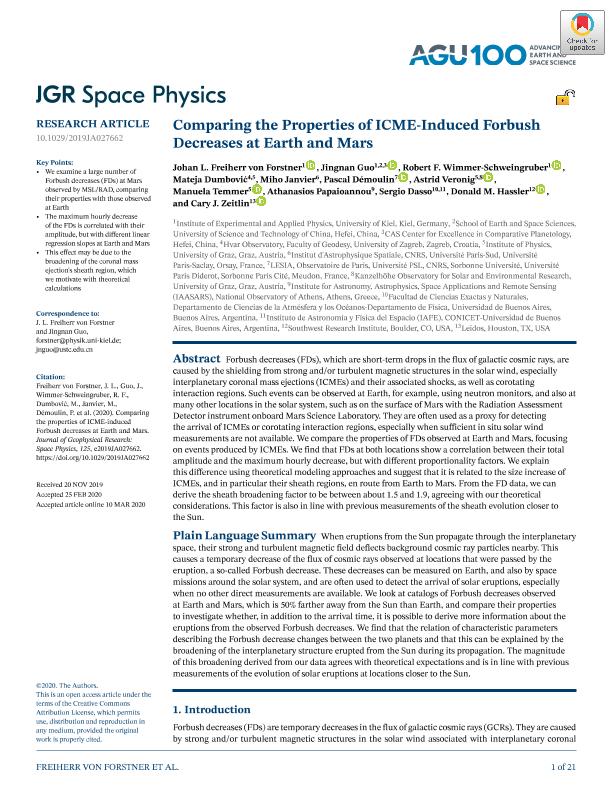Mostrar el registro sencillo del ítem
dc.contributor.author
Freiherr von Forstner, Johan L
dc.contributor.author
Guo, Jingnan
dc.contributor.author
Wimmer Schweingruber, Robert F.
dc.contributor.author
Dumbovic, Mateja
dc.contributor.author
Janvier, Miho
dc.contributor.author
Démoulin, Pascal

dc.contributor.author
Veronig, Astrid
dc.contributor.author
Temmer, Manuela
dc.contributor.author
Papaioannou, Athanasios
dc.contributor.author
Dasso, Sergio Ricardo

dc.contributor.author
Hassler, Donald M.
dc.contributor.author
Zeitlin, Cary J.
dc.date.available
2022-12-27T18:29:53Z
dc.date.issued
2020-03
dc.identifier.citation
Freiherr von Forstner, Johan L; Guo, Jingnan; Wimmer Schweingruber, Robert F.; Dumbovic, Mateja; Janvier, Miho; et al.; Comparing the Properties of ICME-Induced Forbush Decreases at Earth and Mars; Blackwell Publishing; Journal of Geophysical Research: Space Physics; 125; 3; 3-2020; 1-21
dc.identifier.issn
2169-9380
dc.identifier.uri
http://hdl.handle.net/11336/182600
dc.description.abstract
Forbush decreases (FDs), which are short-term drops in the flux of galactic cosmic rays, are caused by the shielding from strong and/or turbulent magnetic structures in the solar wind, especially interplanetary coronal mass ejections (ICMEs) and their associated shocks, as well as corotating interaction regions. Such events can be observed at Earth, for example, using neutron monitors, and also at many other locations in the solar system, such as on the surface of Mars with the Radiation Assessment Detector instrument onboard Mars Science Laboratory. They are often used as a proxy for detecting the arrival of ICMEs or corotating interaction regions, especially when sufficient in situ solar wind measurements are not available. We compare the properties of FDs observed at Earth and Mars, focusing on events produced by ICMEs. We find that FDs at both locations show a correlation between their total amplitude and the maximum hourly decrease, but with different proportionality factors. We explain this difference using theoretical modeling approaches and suggest that it is related to the size increase of ICMEs, and in particular their sheath regions, en route from Earth to Mars. From the FD data, we can derive the sheath broadening factor to be between about 1.5 and 1.9, agreeing with our theoretical considerations. This factor is also in line with previous measurements of the sheath evolution closer to the Sun.
dc.format
application/pdf
dc.language.iso
eng
dc.publisher
Blackwell Publishing

dc.rights
info:eu-repo/semantics/openAccess
dc.rights.uri
https://creativecommons.org/licenses/by/2.5/ar/
dc.subject
FORBUSH DECREASE
dc.subject
GCR
dc.subject
ICME
dc.subject
MARS MISSION
dc.subject
MSL
dc.subject
RADIATION
dc.subject.classification
Astronomía

dc.subject.classification
Ciencias Físicas

dc.subject.classification
CIENCIAS NATURALES Y EXACTAS

dc.title
Comparing the Properties of ICME-Induced Forbush Decreases at Earth and Mars
dc.type
info:eu-repo/semantics/article
dc.type
info:ar-repo/semantics/artículo
dc.type
info:eu-repo/semantics/publishedVersion
dc.date.updated
2020-05-19T19:41:03Z
dc.identifier.eissn
2169-9402
dc.journal.volume
125
dc.journal.number
3
dc.journal.pagination
1-21
dc.journal.pais
Estados Unidos

dc.description.fil
Fil: Freiherr von Forstner, Johan L. Christian Albrechts Universitat Zu Kiel; Alemania
dc.description.fil
Fil: Guo, Jingnan. Christian Albrechts Universitat Zu Kiel; Alemania. University of Science and Technology of China; China. CAS Center for Excellence in Comparative Planetology; China
dc.description.fil
Fil: Wimmer Schweingruber, Robert F.. Christian Albrechts Universitat Zu Kiel; Alemania
dc.description.fil
Fil: Dumbovic, Mateja. University of Zagreb; Croacia. University of Graz; Austria
dc.description.fil
Fil: Janvier, Miho. Université Paris Sud; Francia. Universite Paris-Saclay; . Centre National de la Recherche Scientifique; Francia
dc.description.fil
Fil: Démoulin, Pascal. Laboratoire d'Etudes Spatiales et d'Instrumentation en Astrophysique; Francia. Centre National de la Recherche Scientifique; Francia
dc.description.fil
Fil: Veronig, Astrid. University of Graz; Austria
dc.description.fil
Fil: Temmer, Manuela. University of Graz; Austria
dc.description.fil
Fil: Papaioannou, Athanasios. National Observatory of Athens; Grecia
dc.description.fil
Fil: Dasso, Sergio Ricardo. Universidad de Buenos Aires. Facultad de Ciencias Exactas y Naturales. Departamento de Ciencias de la Atmósfera y los Océanos; Argentina. Consejo Nacional de Investigaciones Científicas y Técnicas. Oficina de Coordinación Administrativa Ciudad Universitaria. Instituto de Astronomía y Física del Espacio. - Universidad de Buenos Aires. Facultad de Ciencias Exactas y Naturales. Instituto de Astronomía y Física del Espacio; Argentina
dc.description.fil
Fil: Hassler, Donald M.. Southwest Research Institute.; Estados Unidos
dc.description.fil
Fil: Zeitlin, Cary J.. Leidos; Estados Unidos
dc.journal.title
Journal of Geophysical Research: Space Physics
dc.relation.alternativeid
info:eu-repo/semantics/altIdentifier/url/https://onlinelibrary.wiley.com/doi/abs/10.1029/2019JA027662
dc.relation.alternativeid
info:eu-repo/semantics/altIdentifier/doi/http://dx.doi.org/10.1029/2019JA027662
Archivos asociados
